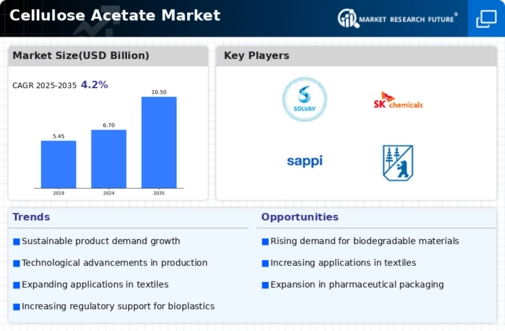Top Industry Leaders in the Cellulose Acetate Market
 The cellulose acetate market is a dynamic and evolving space. Characterized by its biodegradable and versatile nature, cellulose acetate finds application in various industries, from textiles and cigarette filters to pharmaceuticals and electronics. This report delves into the competitive landscape, analyzing key players, strategies, market share dynamics, and recent developments shaping the future of this sector.
The cellulose acetate market is a dynamic and evolving space. Characterized by its biodegradable and versatile nature, cellulose acetate finds application in various industries, from textiles and cigarette filters to pharmaceuticals and electronics. This report delves into the competitive landscape, analyzing key players, strategies, market share dynamics, and recent developments shaping the future of this sector.
Market Leaders and Strategies:
-
Eastman Chemical Company (USA): A global leader with a strong presence in North America and Asia, Eastman adopts a multi-pronged approach, focusing on R&D for innovative applications, capacity expansions, and strategic partnerships. Their "Acetate Tow" brand enjoys significant recognition in the textile industry. -
Solvay (Belgium): A European powerhouse, Solvay emphasizes sustainability and resource efficiency. Their "Cellulose Acetate Filaments" are widely used in cigarette filters and offer superior filtration performance. They also invest in bio-based feedstocks for cellulose acetate production, aligning with the growing demand for eco-friendly materials. -
Mitsubishi Chemical Holdings Corporation (Japan): A major player in Asia, Mitsubishi focuses on high-performance cellulose acetate grades for specific applications like membranes and films. They also leverage their strong distribution network and presence in emerging markets to drive market share.
Factors Influencing Market Share:
-
Product Innovation: The ability to develop new and improved cellulose acetate grades with enhanced properties like fire resistance or biodegradability can significantly impact market share. -
Cost Competitiveness: Optimizing production processes and sourcing raw materials cost-effectively is crucial for staying competitive, especially in price-sensitive applications like cigarette filters. -
Sustainability Initiatives: Growing environmental concerns and regulations favoring sustainable materials are pushing players to adopt eco-friendly practices and bio-based feedstocks, creating differentiation. -
Regional Expansion: Expanding into new markets with high demand potential, particularly in Asia and developing economies, can offer significant growth opportunities.
Key Companies in the cellulose acetate market include
-
Solvay (Belgium)
-
Celanese Corporation (U.S.)
-
Daicel Corporation (Japan)
-
Accords Cellulosic Fibers Inc. (U.S.)
-
China National Tobacco Corporation (China)
-
SK Chemicals (South Korea)
-
Sappi (South Africa)
-
Rayonier Advanced Materials (U.S.)
-
Sichuan Push Acetate Co. Ltd.(China)
-
Borregaard (Norway)
-
Eastman Chemical Company (U.S.)
Recent Developments:
In November 2020, Blue Ridge was established by Celanese Corporation, a technology and specialized materials firm based in the United States. Blue Ridge is a cellulose acetate product that can be used to make backyard composting or biodegradable items such as straws.
In November 2020, Sappi, the world's largest dissolving pulp firm, has announced a collaboration with Birla Cellulose, a key manufacturer in the textile value chain. The collaboration aims to provide brand owners with a forest-to-garment traceability solution. This collaboration will help the company's sustainability credentials in the textile industry.
in February 2020, Mazzucchelli 1849 S.p.A., an Italy-based manufacturer and distributor of cellulose acetate, collaborated with Eastman Chemical Company to develop and market acetate sheets produced with Eastman Acetate Renew, a cellulose diacetate that contains 60% bio-based and 40% verified recycled material.
In August 2023, Eastman Chemical Company, another major producer of cellulose acetate, announced that it is developing a new grade of cellulose acetate that is specifically designed for use in 3D printing applications. The new grade of cellulose acetate is expected to be available in commercial quantities in 2024.

